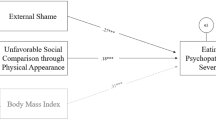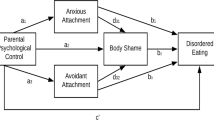Abstract
Purpose
Body shame has been strongly associated with eating pathology. However, less is known about the predisposing factors linked to these feelings and how they interact with other variables in eating disorder development. Thus, the aim of the present study was to provide a preliminary understanding of the relationship between body shame and some of the major risk factors for eating disorder onset, identifying the possible mechanisms of action. Specifically, we tested a structural equation model in which perceived parental bonding, self-esteem, perfectionism, and body mass index are associated with eating disorder risk via body shame.
Methods
1156 high school students aged 13–20 were screened by means of self-report measures of parental behavior, self-esteem, perfectionism, body shame and eating disorder risk. The height and weight of each individual were measured.
Results
In predicting eating disorder risk, parental protectiveness (β = 0.09), body mass index (β = 0.18), self-esteem (β = − 0.14) and body shame (β = 0.58) had a direct effect on this variable and overall our model accounted for 58% of its variance. The experience of shame related to one’s body appeared to have a considerably significant influence on eating disturbances vulnerability and it also serves as a mediator between other risk factors and eating disturbance risk. A series of multi-group analyses indicated no significant difference between males and females.
Conclusion
The emotion of shame may enhance our understanding of eating disorders, as well as being a salient factor for the development of preventive programs and treatment approaches.
Level of evidence
Level V, cross-sectional descriptive study.



Similar content being viewed by others
References
Andrews B, Qian M, Valentine JD (2002) Predicting depressive symptoms with a new measure of shame: the experience of shame scale. Br J Clin Psychol 41:29–42. https://doi.org/10.1348/014466502163778
Goss K, Gilbert P (2002) Eating disorders, shame and pride: a cognitive-behavioural functional analysis. In: Gilbert P, Miles J (eds) Body shame: conceptualisation, research and treatment. Brunner-Routledge, Hove, pp 219–255
Troop NA, Redshaw C (2012) General shame and bodily shame in eating disorders: a 2.5-year longitudinal study. Eur Eat Disord 20:373–378. https://doi.org/10.1002/erv.2160
Doran J, Lewis CA (2012) Components of shame and eating disturbance among clinical and non-clinical populations. Eur Eat Disord 20:265–270. https://doi.org/10.1002/erv.1142
Duarte C, Pinto-Gouveia J, Ferreira C (2014) Escaping from body image shame and harsh self-criticism: exploration of underlying mechanisms of binge eating. Eat Behav 15:638–643. https://doi.org/10.1016/j.eatbeh.2014.08.025
Higgins MK, Lin SL, Alvarez A, Bardone-Cone AM (2015) Examining impulsivity as a moderator of the relationship between body shame and bulimic symptoms in Black and White young women. Body Image 14:39–46. https://doi.org/10.1016/j.bodyim.2015.03.007
Skårderud F (2007) Shame and pride in anorexia nervosa: a qualitative descriptive study. Eur Eat Disord 15:81–97. https://doi.org/10.1002/erv.774
Cavalera C, Pagnini F, Zurloni V, Diana B, Realdon O, Castelnuovo G, Todisco P, Molinari E (2016) Shame proneness and eating disorders: a comparison between clinical and non-clinical samples. Eat Weight Disord 21:701–707. https://doi.org/10.1007/s40519-016-0328-y
Rosenberg M (1965) Society and the adolescent self-image. Princeton University Press, Princeton
Sassaroli S, Gallucci M, Ruggiero GM (2008) Low perception of control as a cognitive factor of eating disorders. Its independent effects on measures of eating disorders and its interactive effects with perfectionism and self-esteem. J Behav Ther Exp Psy 39:467–488. https://doi.org/10.1016/j.jbtep.2007.11.005
Shea ME, Pritchard ME (2007) Is self-esteem the primary predictor of disordered eating? Pers Individ Differ 42:1527–1537. https://doi.org/10.1016/j.paid.2006.10.026
Tylka TL, Subich LM (2004) Examining a multidimensional model of eating disorder symptomatology among college women. J Couns Psychol 51:314–328. https://doi.org/10.1037/0022-0167.51.3.314
Iannaccone M, D’Olimpio F, Cella S, Cotrufo P (2016) Self-esteem, body shame and eating disorder risk in obese and normal weight adolescents: a mediation model. Eat Behav 2:80–83. https://doi.org/10.1016/j.eatbeh.2015.12.010
Sim LA, Lebow J, Billings M (2013) Eating disorders in adolescents with a history of obesity. Pediatrics 132:e1026–e1030. http://www.pediatrics.org/. https://doi.org/10.1542/peds.2012-3940
Sjöberg RL, Nilsson KW, Leppert J (2005) Obesity, shame, and depression in school-aged children: a population-based study. Pediatrics 116:e389–e392. https://doi.org/10.1542/peds.2005-0170
Mensinger JL, Tylka TL, Calamari ME (2018) Mechanisms underlying weight status and healthcare avoidance in women: a study of weight stigma, body-related shame and guilt, and healthcare stress. Body Image 25:139–147. https://doi.org/10.1016/j.bodyim.2018.03.001
Moreira H, Canavarro MC (2017) Is body shame a significant mediator of the relationship between mindfulness skills and the quality of life of treatment-seeking children and adolescents with overweight and obesity? Body Image 20:49–57. https://doi.org/10.1016/j.bodyim.2016.11.004
Lissau I, Sørensen TI (1994) Parental neglect during childhood and increased risk of obesity in young adulthood. Lancet 5:324–327. https://doi.org/10.1016/S0140-6736(94)91163-0
Frost RO, Marten P, Lahart CM, Rosenblate R (1990) The Dimensions of perfectionism. Cogn Ther Res 14:449–468. https://doi.org/10.1007/BF01172967
Holland LA, Bodell LP, Keel PK (2013) Psychological factors predict eating disorder onset and maintenance at 10-year follow-up. Eur Eat Disord 21:405–410. https://doi.org/10.1002/erv.2241
Egan SJ, Wade TD, Shafran R (2011) Perfectionism as a transdiagnostic process: a clinical review. Clin Psychol Rev 31:203–212. https://doi.org/10.1016/j.cpr.2010.04.009
Boone L, Soenens B, Vansteenkiste M, Braet C (2012) Is there a perfectionist in each of us? An experimental study on perfectionism and eating disorder symptoms. Appetite 59:531–540. https://doi.org/10.1016/j.appet.2012.06.015
Joyce F, Watson HJ, Egan SJ, Kane RT (2012) Mediators between perfectionism and eating disorder psychopathology in a community sample. Eat Behav 13:361–365. https://doi.org/10.1016/j.eatbeh.2012.07.002
Ferreira C, Trindade IA, Ornelas L (2015) Exploring drive for thinness as a perfectionistic strategy to escape from shame experiences. Span J Psychol 20:18:E29. https://doi.org/10.1017/sjp.2015.27
Marta-Simões J, Ferreira C (2016) Seeking a perfect body look: feeding the pathogenic impact of shame? Eat Weight Disord 21:477–485. https://doi.org/10.1007/s40519-015-0240-x
Oliveira S, Trindade IA, Ferreira C (2018) Explaining male body attitudes: the role of early peer emotional experiences and shame. Eat Weight Disord. https://doi.org/10.1007/s40519-018-0569-z
Duarte C, Pinto-Gouveia J, Stubbs RJ (2017) The prospective associations between bullying experiences, body image shame and disordered eating in a sample of adolescent girls. Pers Individ Differ 116:319–325. https://doi.org/10.1016/j.paid.2017.05.003
Andrews B (1997) Bodily shame in relation to abuse in childhood and bulimia: a preliminary investigation. Br J Clin Psychol 36:41–49. https://doi.org/10.1111/j.2044-8260.1997.tb01229.x
Talmon A, Ginzburg K (2018) “Body self” in the shadow of childhood sexual abuse: the long-term implications of sexual abuse for male and female adult survivors. Child Abuse Negl 76:416–425. https://doi.org/10.1016/j.chiabu.2017.12.004
Jáuregui Lobera I, Bolaños Ríos P, Garrido Casals O (2011) Parenting styles and eating disorders. J Psychiatr Ment Health Nurs 18:728–735. https://doi.org/10.1111/j.1365-2850.2011.01723.x
Perry JA, Silvera DH, Neilands TB, Rosenvinge JH, Hanssen T (2008) A study of the relationship between parental bonding, self-concept and eating disturbances in Norwegian and American college populations. Eat Behav 9:13–24. https://doi.org/10.1016/j.eatbeh.2007.01.007
Cella S, Iannaccone M, Cotrufo P (2014) How perceived parental bonding affects self-concept and drive for thinness: a community-based study. Eat Behav 15:110–115. https://doi.org/10.1016/j.eatbeh.2013.10.024
Lutwak N, Ferrari JR (1997) Understanding shame in adults: retrospective perceptions of parental bonding during childhood. J Nerv Ment Dis 185:595–598. https://doi.org/10.1097/00005053-199710000-00001
Leung N, Thomas G, Waller G (2000) The relationship between parental bonding and core beliefs in anorexic and bulimic women. Br J Clin Psychol 39:205–213. https://doi.org/10.1348/014466500163220
Murray C, Waller G, Legg C (2000) Family dysfunction and bulimic psychopathology: the mediating role of shame. Int J Eat Disord 28:84–89. https://doi.org/10.1002/(SICI)1098-108X(200007)28
Turner HM, Rose KS, Cooper MJ (2005) Parental bonding and eating disorder symptoms in adolescents: the meditating role of core beliefs. Eat Behav 6:113–118. https://doi.org/10.1016/j.eatbeh.2004.08.010
Markham A, Thompson T, Bowling A (2005) Determinants of body-image shame. Pers Individ Differ 38:1529–1541. https://doi.org/10.1016/j.paid.2004.08.018
Parker G, Tupling H, Brown LB (1979) A parental bonding instrument. Br J Med Psychol 52:1–10. https://doi.org/10.1111/j.2044-8341.1979.tb02487.x
Garner DM (2004) Eating Disorder Inventory-third edition (EDI-3). Psychological Assessment Resources, Lutz
Segura-García C, Aloi M, Rania M, Ciambrone P, Palmieri A, Pugliese V, Ruiz Moruno AJ, De Fazio P (2015) Ability of EDI-2 and EDI-3 to correctly identify patients and subjects at risk for eating disorders. Eat Behav 19:20–23. https://doi.org/10.1016/j.eatbeh.2015.06.010
Jöreskog KG, Sörbom D (2006) LISREL 8.80 for Windows. Scientific Software International, Lincolnwood
Anderson JC, Gerbing DW (1988) Structural equation modeling in practice: a review and recommended two-step approach. Psychol Bull 103:411–423. https://doi.org/10.1037/0033-2909.103.3.411
Hoyle RH, Panter AT (1995) Writing about structural equation models. In: Hoyle RH (ed) Structural equation modeling: concepts, issues, and applications. Sage, Newbury Park
Steiger JH (1990) Structural model evaluation and modification: an interval estimation approach. Multivar Behav Res 25:173–180. https://doi.org/10.1207/s15327906mbr2502_4
Bentler PM (1990) Comparative fit indexes in structural models. Psychol Bull 107:238–246. https://doi.org/10.1037/0033-2909.107.2.238
Bentler PM, Bonnet DC (1980) Significance tests and goodness of fit in the analysis of covariance structures. Psychol Bull 88:588–606. https://doi.org/10.1037/0033-2909.88.3.588
Satorra A, Bentler PM (2001) A scaled difference Chi-square test statistic for moment structure analysis. Psychometrika 66:507–514. https://doi.org/10.1007/BF02296192
Cheung GW, Rensvold RB (2002) Evaluating goodness-of-fit indexes for testing measurement invariance. Struct Equ Model 9:233–255. https://doi.org/10.1207/S15328007SEM0902_5
Byrne BM (1998) Structural equation modeling with LISREL, PRELIS and SIMPLIS: basic concepts, applications and programming. Lawrence Erlbaum Associates Publishers, Mahwah
Byrne BM (2006) Structural equation modeling with EQS: basic concepts, applications and programming, 2nd edn. Lawrence Erlbaum Associates Publishers, Mahwah
Horn JL, McArdle JJ (1992) A practical and theoretical guide to measurement invariance in aging research. Exp Aging Res 105:117–144. https://doi.org/10.1080/03610739208253916
Tangney JP (1992) Situational determinants of shame and guilt in young adulthood. Pers Soc Psychol Bull 18:199–206. https://doi.org/10.1177/0146167292182011
Swanson H, Power K, Collin P, Deas S, Paterson G, Grierson D, Yellowlees A, Park K, Taylor L (2010) The relationship between parental bonding, social problem solving and eating pathology in an anorexic inpatient sample. Eur Eat Disord 18:22–32. https://doi.org/10.1002/erv.967
Grenon R, Tasca GA, Maxwell H, Balfour L, Proulx G, Bissada H (2016) Parental bonds and body dissatisfaction in a clinical sample: the mediating roles of attachment anxiety and media internalization. Body Image 19:49–56. https://doi.org/10.1016/j.bodyim.2016.08.005
Levinson CA, Rodebaugh TL, White EK, Menatti AR, Weeks JW, Iacovino JM, Warren CS (2013) Social appearance anxiety, perfectionism, and fear of negative evaluation: distinct or shared risk factors for social anxiety and eating disorders? Appetite 67:125–133. https://doi.org/10.1016/j.appet.2013.04.002
Fairburn CG (1995) Overcoming binge eating. Guilford Press, New York
Wade TD, Wilksch SM, Paxton SJ, Byrne SM, Austin SB (2015) How perfectionism and ineffectiveness influence growth of eating disorder risk in young adolescent girls. Behav Res Ther 66:56–63. https://doi.org/10.1016/j.brat.2015.01.007
Hewitt PL, Flett GL, Ediger E (1995) Perfectionism traits and perfectionistic self-presentation in eating disorder attitudes, characteristics, and symptoms. Int J Eat Disord 18:317–326. https://doi.org/10.1002/1098-108X(199512)18:4%3C317
Button EJ, Loan P, Davies J, Sonuga-Barke EJ (1997) Self-esteem, eating problems, and psychological well-being in a cohort of schoolgirls aged 15–16: a questionnaire and interview study. Int J Eat Disord 21:39–47. https://doi.org/10.1002/(SICI)1098-108X(199701)21
Oliveira S, Trindade IA, Ferreira C (2018) The buffer effect of body compassion on the association between shame and body and eating difficulties. Appetite 125:118–123. https://doi.org/10.1016/j.appet.2018.01.031
Dias BS, Ferreira C, Trindade IA (2018) Influence of fears of compassion on body image shame and disordered eating. Eat Weight Disord. https://doi.org/10.1007/s40519-018-0523-0
Cella S, Cipriano A, Iannaccone M, Cotrufo P (2017) Identifying predictors associated with the severity of eating concerns in females with eating disorders. RIPPPO 20:91–99. https://doi.org/10.4081/ripppo.2017.19
Baker J, White N, Mengersen K (2014) Missing in space: an evaluation of imputation methods for missing data in spatial analysis of risk factors for type II diabetes. Int J Health Geogr 13:47. https://doi.org/10.1186/1476-072X-13-47
Funding
No funding was received.
Author information
Authors and Affiliations
Contributions
PC designed the study and wrote the protocol. SC and MI conducted literature searches and provided summaries of previous research studies. SC and MI conducted the statistical analysis and wrote the first draft of the manuscript. All authors contributed to and have approved the final manuscript.
Corresponding author
Ethics declarations
Conflict of interest
The authors declare that they have no conflicts of interest.
Ethical approval
All procedures performed in studies involving human participants were in accordance with the ethical standards of the institutional and/or national research committee and with the 1964 Helsinki declaration and its later amendments or comparable ethical standards.
Informed consent
Informed consent was obtained from all individual participants included in the study.
Additional information
Publisher’s Note
Springer Nature remains neutral with regard to jurisdictional claims in published maps and institutional affiliations.
Rights and permissions
About this article
Cite this article
Cella, S., Iannaccone, M. & Cotrufo, P. Does body shame mediate the relationship between parental bonding, self-esteem, maladaptive perfectionism, body mass index and eating disorders? A structural equation model. Eat Weight Disord 25, 667–678 (2020). https://doi.org/10.1007/s40519-019-00670-3
Received:
Accepted:
Published:
Issue Date:
DOI: https://doi.org/10.1007/s40519-019-00670-3




